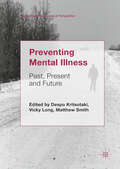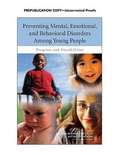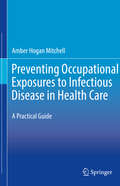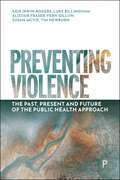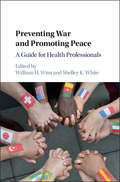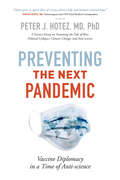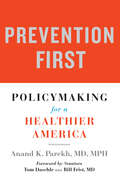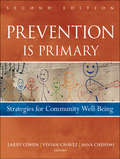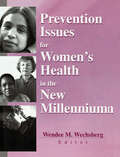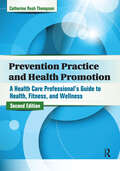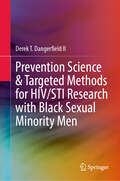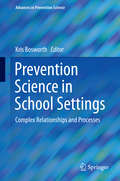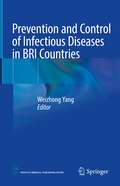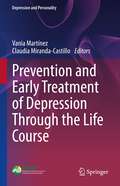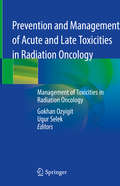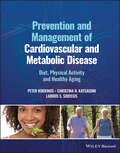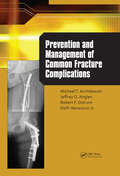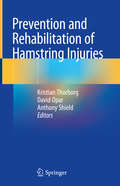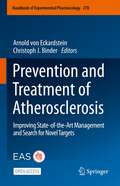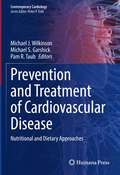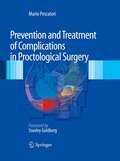- Table View
- List View
Preventing Mental Ill-Health: Informing public health planning and mental health practice
by Jennifer NewtonIs there any evidence that we can reduce the incidence of mental ill health? Is it possible to prevent recurrence of mental ill health? Aspirations to achieve both these goals have featured in mental health policy and practice for over 100 years. This comprehensive and accessible book draws on research on the development and persistence of behavioural problems in childhood, adult depression and schizophrenia. The association between social disadvantage and mental ill health, as well as the need for preventive care to start from conception and the crucial importance of maternal mental health, are discussed. A variety of prominent programmes which have good evidence of efficacy are described. These include: Targeted approaches with individuals and families Macro policies affecting housing and employment Lifestyle contributions such as diet and exercise However, some attempts to achieve preventive benefits have not succeeded, and reflecting on these problems is an important feature of this review. Jennifer Newton has written extensively on these issues for over twenty years, and her careful examination of the research literature provides a succinct overview of the state of current knowledge which will benefit mental health professionals, and students of health psychology and public health. It also takes a life course perspective, and considers how, when and why vulnerability persists through childhood into adult life, so will interest those whose work focuses on child well-being.
Preventing Mental Illness: Past, Present and Future (Mental Health in Historical Perspective)
by Matthew Smith Vicky Long Despo KritsotakiThis book provides an overview of a diverse array of preventive strategies relating to mental illness, and identifies their achievements and shortcomings. The chapters in this collection illustrate how researchers, clinicians and policy makers drew inspiration from divergent fields of knowledge and practice: from eugenics, genetics and medication to mental hygiene, child guidance, social welfare, public health and education; from risk management to radical and social psychiatry, architectural design and environmental psychology. It highlights the shifting patterns of biological, social and psychodynamic models, while adopting a gender perspective and considering professional developments as well as changing social and legal contexts, including deinstitutionalisation and social movements. Through vigorous research, the contributors demonstrate that preventive approaches to mental health have a long history, and point to the conclusion that it might well be possible to learn from such historical attempts. The book also explores which of these approaches are worth considering in future and which are best confined to the past. Within this context, the book aims at stoking and informing debate and conversation about how to prevent mental illness and improve mental health in the years to come.Chapters 3, 10, and 12 of this book are available open access under a CC BY 4.0 license at link.springer.com
Preventing Mental, Emotional, and Behavioral Disorders Among Young People: Progress and Possibilities
by National Research Council Institute of Medicien of the National AcademiesFor multi-user PDF licensing, please contact mailto:customer_service@nap.edu customer service. Mental health and substance use disorders among children, youth, and young adults are major threats to the health and well-being of younger populations which often carryover into adulthood. The costs of treatment for mental health and addictive disorders, which create an enormous burden on the affected individuals, their families, and society, have stimulated increasing interest in prevention practices that can impede the onset or reduce the severity of the disorders. Prevention practices have emerged in a variety of settings, including programs for selected at-risk populations (such as children and youth in the child welfare system), school-based interventions, interventions in primary care settings, and community services designed to address a broad array of mental health needs and populations. Preventing Mental, Emotional, and Behavioral Disorders Among Young People updates a 1994 Institute of Medicine book, Reducing Risks for Mental Disorders, focusing special attention on the research base and program experience with younger populations that have emerged since that time. Researchers, such as those involved in prevention science, mental health, education, substance abuse, juvenile justice, health, child and youth development, as well as policy makers involved in state and local mental health, substance abuse, welfare, education, and justice will depend on this updated information on the status of research and suggested directions for the field of mental health and prevention of disorders.
Preventing Miscarriage: The Good News
by Jonathan Scher Carol Dix“A wonderfully written text that will provide clear, up-to-date explanations for complex medical problems involving recurrent pregnancy loss. The personal accounts allow us all to be inspired by the desire to reproduce!” — Andrei Rebarber, M.D., clinical associate professor, Mount Sinai School of Medicine, New York; president, Maternal Fetal Medicine Associates, PLLCA Reassuring and Informative Guide That Offers New Hope For Expectant ParentsAlong with inspiring accounts of women who have delivered healthy babies after years of heartbreak, Dr. Jonathan Scher provides the latest medical information on preventing recurrent miscarriages, including why couples with "unexplained infertility" actually may be suffering repeat pregnancy loss due to failure of the embryo to implant in the womb, important immunological and tissue tests that may explain or prevent miscarriage, emerging treatments such as heparin and I.V.I.G., updated resources, and much more.
Preventing Occupational Exposures to Infectious Disease in Health Care: A Practical Guide
by Amber Hogan MitchellThis book is a practical guide for preventing occupational exposures to bloodborne and infectious disease in health care. It is a timely and essential resource given that people working in healthcare settings sustain a higher incidence of occupational illness than any other industry sector, and at the time of publication of this book we are in the midst of a global pandemic of COVID-19. While the guide is focused on health care primarily, it would be useful for preventing exposures to essential workers in many other industries as well.The guide offers easy-to-follow instruction, all in one place, for creating, implementing, and evaluating occupational health and safety programs. Readers have practical information that they can use now to either build a new program or expand an existing one that protects workers from occupationally associated illness and infection. With a focus on the public health significance of building better, safer programs in health care, the book provides not just the evidence-based or data-driven reasoning behind building successful programs, but also includes sample programs, plans, checklists, campaigns, and record-keeping and surveillance tools. Topics explored among the chapters include: • Occupational Safety and Health Administration (OSHA) Regulatory Compliance • Other Regulatory Requirements, National Standards, and Accreditation • Performing a Hazard Assessment and Building an Exposure Control Plan • Engineering Controls and Safer Medical Devices • Personal Protective Equipment Placement and Use • Facing a Modern PandemicPreventing Occupational Exposures to Infectious Disease in Health Care is a comprehensive resource for both seasoned and novice professionals with primary, secondary, or ancillary responsibility for occupational or employee health and safety, infection prevention, risk management, or environmental health and safety in a variety of healthcare or patient care settings. It also would appeal to those working in public health, nursing, medical, or clinical technical trades with an interest in infection prevention and control and/or occupational health and infectious disease.
Preventing Violence: The Past, Present and Future of the Public Health Approach
by Tim Newburn Alistair Fraser Luke Billingham Keir Irwin-Rogers Susan McVie Fern GillonAvailable open access digitally under CC-BY-NC-ND licence. Preventing Violence argues that we can move towards safer and better societies by advancing holistic public health approaches to violence prevention. It explores the serious limitations of contemporary public health approaches and proposes an alternative path forward. Based on data from a three-year, ESRC-funded project 'Public Health, Youth and Violence Reduction', it also examines in-depth the work of 20 Violence Reduction Units in England and Wales. The book makes clear recommendations for policy makers, practitioners and researchers working to prevent violence and improve the lives of children and young people.
Preventing War and Promoting Peace: A Guide for Health Professionals
by William H. Wiist Shelley K. WhitePreventing War and Promoting Peace: A Guide for Health Professionals is an interdisciplinary study of how pervasive militarism creates a propensity for war through the influence of academia, economic policy, the defense industry, and the news media. Comprising contributions by academics and practitioners from the fields of public health, medicine, nursing, law, sociology, psychology, political science, and peace and conflict studies, as well as representatives from organizations active in war prevention, the book emphasizes the underlying preventable causes of war, particularly militarism, and focuses on the methods health professionals can use to prevent war. Preventing War and Promoting Peace provides hard-hitting facts about the devastating health effects of war and a broad perspective on war and health, presenting a new paradigm for the proactive engagement of health professions in the prevention of war and the promotion of peace.
Preventing and Treating Missing Data in Longitudinal Clinical Trials
by Craig H. MallinckrodtRecent decades have brought advances in statistical theory for missing data, which, combined with advances in computing ability, have allowed implementation of a wide array of analyses. In fact, so many methods are available that it can be difficult to ascertain when to use which method. This book focuses on the prevention and treatment of missing data in longitudinal clinical trials. Based on his extensive experience with missing data, the author offers advice on choosing analysis methods and on ways to prevent missing data through appropriate trial design and conduct. He offers a practical guide to key principles and explains analytic methods for the non-statistician using limited statistical notation and jargon. The book's goal is to present a comprehensive strategy for preventing and treating missing data, and to make available the programs used to conduct the analyses of the example dataset.
Preventing the Next Pandemic: Vaccine Diplomacy in a Time of Anti-science
by Peter J. HotezThe last five years saw a significant return of epidemic infectious disease, culminating in COVID-19. In our new post–COVID-19 world, how do we prevent future illnesses by expanding scientific and vaccine diplomacy and cooperation, especially to combat the problems that humans have brought on ourselves?Modern diseases and viruses have been spurred anew by war and conflict as well as shifting poverty, urbanization, climate change, and a new troubling anti-science/anti-vaccination outlook. From such twenty-first-century forces, we have seen declines in previous global health gains, with sharp increases in vaccine-preventable and neglected diseases on the Arabian Peninsula, in Venezuela, in parts of Africa, and even on the Gulf Coast of the United States. In Preventing the Next Pandemic, international vaccine scientist and tropical disease and coronavirus expert Peter J. Hotez, MD, PhD, argues that we can—and must—rely on vaccine diplomacy to address this new world order in disease and global health. Detailing his years in the lab developing new vaccines, Hotez also recounts his travels around the world to shape vaccine partnerships with people in countries both rich and poor in an attempt to head off major health problems. Building on the legacy of Dr. Albert Sabin, who developed the oral polio vaccine with Soviet scientists at the height of the Cold War, he explains how he is still working to refresh and redirect vaccine diplomacy toward neglected and newly emerging diseases. Hotez reveals how—during his Obama-era tenure as the US Science Envoy for the Middle East and North Africa, which coincided with both the rise in these geopolitical forces and climate change—he witnessed tropical infectious diseases and established vaccine partnerships that may still combat them up close. He explores why, since 2015, we've seen the decline of global cooperation and cohesion, to the detriment of those programs that are meant to benefit the most vulnerable people in the world. Unfortunately, Hotez asserts, these negative global events kick off a never-ending loop. Problems in a country may lead to disease outbreaks, but those outbreaks can lead to further problems—such as the impact of coronavirus on China's society and economy, which has been felt around the globe. Zeroing in on the sociopolitical and environmental factors that drive our most controversial and pressing global health concerns, Hotez proposes historically proven methods to soothe fraught international relations while preparing us for a safer, healthier future. He hammers home the importance of public engagement to communicate the urgency of embracing science during troubled times. Touching on a range of disease, from leishmaniasis, schistosomiasis, and Middle East Respiratory Syndrome (MERS) to COVID-19, Preventing the Next Pandemic has always been a timely goal, but it will be even more important in a COVID and post-COVID world.
Prevention First: Policymaking for a Healthier America
by Anand K. ParekhDeaths from preventable disease have decreased life expectancy in the United States for the first time in a century. This book argues that we must deal with the crisis by embracing prevention as our nation's top health sector priority.In Prevention First, Dr. Anand K. Parekh, chief medical advisor of the Bipartisan Policy Center, argues that disease prevention must be our nation's top health policy priority. Building a personal culture of prevention, he writes, is not enough; elected officials and policymakers must play a greater role in reducing preventable deaths. Drawing on his experiences as a clinician, public servant, and policy advisor, Dr. Parekh provides examples of prevention in action from across the country, giving readers a view into why prevention-first policies are important and how they can be accomplished. Throughout the book, he demonstrates that, in order to optimize health in America, we must leverage health insurance programs to promote disease prevention, expand primary care, attend to the social determinants of health, support making the healthier choice the easy choice for individuals, and increase public health investments.Describing the areas of common ground to be found in public health and prevention, even between the entrenched sides in the healthcare policy debate, Dr. Parekh establishes a foundation on which healthcare policy makers and advocates can build. Providing concrete steps that federal policymakers should take to promote prevention both within and outside our healthcare sector, Prevention First not only sounds the alarm about the terrible consequences of preventable disease but serves as a rallying cry that we can and must do better in this country to reduce preventable deaths.
Prevention Is Primary
by Sana Chehimi Larry Cohen Vivian ChavezThe new edition of Prevention Is Primary provides models, methods, and approaches for building health and equity in communities. This comprehensive book includes the theory, concepts, and models needed to harness social justice and practice primary prevention of unnecessary illness and injury. Ideal for students as well as practitioners, this thoroughly revised and updated second edition combines an overview of advances in the field with effective approaches in the current economic and health care climate. With contributions from noted experts, Prevention Is Primary shows practical applications of intervention science to social and health problems and issues facing at-risk and vulnerable groups. The book describes the overarching framework and principles guiding prevention efforts, including a focus on social justice and health equity, and community resilience. It explores the transition from prevention theory to implementation and practice and from interdisciplinary collaboration to evaluation. Highlighting the book's usefulness as a teaching and learning tool, Prevention Is Primary has real world examples, learning objectives, and review questions for each chapter.
Prevention Issues for Women's Health in the New Millennium
by Wendee WechsbergWhere are the fields of prevention and health promotion for women headed?This valuable book illuminates the need for-and the gains that can be achieved by-targeting prevention/health promotion programs toward minority and low-income women in the communities where they live.Reflecting the rise of women&’s health issues to a national priority in the last decade, Prevention Issues for Women&’s Health in the New Millennium explores the individual and contextual factors-biological, sociocultural, economic, and environmental-that affect the quality and length of women&’s lives. It examines current research on disease prevention and the need for health promotion, particularly with minority and hard-to-reach women, and suggests directions for future investigation.Rather than generalizing or pontificating, Prevention Issues for Women&’s Health in the New Millennium looks up close at specific studies designed to answer questions such as: What kinds of health promotion programs could make the biggest difference in the lives of Native American women, today and tomorrow? How effective are cancer education/support programs for rural women, and what can be done to improve their efficacy? How does sexual orientation influence women&’s patterns of health-related behavior? How can female substance abusers lessen the distress issues that often bring on risky behavior? How can we more effectively reach African-American women, who are twice as likely as Caucasian women to develop diabetes, hypertension, and stroke?Well referenced and complete with user-friendly tables that make the statistics of each study easy to work with, Prevention Issues for Women&’s Health in the New Millennium brings you an incisive look at issues that will become prevention priorities in the near future.
Prevention Practice and Health Promotion: A Health Care Professional’s Guide to Health, Fitness, and Wellness
by Catherine Rush ThompsonThe all-encompassing Second Edition of Prevention Practice and Health Promotion: A Health Care Professional’s Guide to Health, Fitness, and Wellness offers foundational knowledge to health care professionals implementing primary, secondary, and tertiary prevention to healthy, at-risk, and disabled populations.Dr. Catherine Thompson along with her contributors, all with diverse backgrounds in physical therapy, rehabilitation, and healthcare, present the interdisciplinary health care perspective of health, fitness, and wellness concepts that are critical for providing preventive care to healthy, impaired, and at-risk populations using the World Health Organization’s International Classification of Functioning, Disability, and Health model as a guideline for assessment and management.Based upon the goals outlined in Healthy People 2020, Prevention Practice and Health Promotion, Second Edition also combines the vision of direct access for health care professionals with the goals of national health care to increase the quality of years of healthy life, as well as to eliminate health disparities between various populations. Recognizing the cost effectiveness of preventive care, health care professionals have an expanded role in health promotion and wellness, complementing evidence-based medical management of acute and chronic conditions.Some topics covered inside Prevention Practice and Health Promotion, Second Edition include an overview of screening across the lifespan; effective interventions to promote health, fitness, and wellness; and options for program development, including marketing and management strategies to address both individual and community needs.Included with the text are online supplemental materials for faculty use in the classroom.Features of the Second Edition:• Use of the American Physical Therapy Association’s Guide to Physical Therapist Practice, Second Edition for health promotion• Screening tools for special populations, including children, pregnant women, older adults, individuals with developmental disabilities, and people with chronic conditions affecting their quality of life• Resources to promote healthy living, including nutrition, stress management, fitness training, and injury preventionPerfect for clinicians, students, allied health professionals, rehabilitation specialists, physical medicine specialists, and recreation therapists, the Second Editionto Prevention Practice and Health Promotion is a valuable resource for everyone in the areas of health, fitness, and wellness.
Prevention Science & Targeted Methods for HIV/STI Research with Black Sexual Minority Men
by Derek T. Dangerfield IIDespite substantial advances in HIV/STI treatment and prevention for general population health, sexual health disparities persist for Black gay, bisexual, and other Black sexual minority men (SMM). Strategies to build trust and overcome barriers are not well-established and solutions remain elusive. The contemporary prevention science landscape also requires updated perspectives in light of changing social policies, technological advancements, and prevention options. This book is the first to provide a comprehensive overview for sexual health prevention science using years of significant research from Dangerfield II et al. involving U.S. Black SMM in light of existing studies. This book identifies knowledge and practice gaps and proposes recommendations for innovative methods for academic collaboration with communities of practice. Researchers, clinicians, and public health practitioners will be guided through the sexual health research and intervention process using targeted contemporary studies to enhance their practice. This book serves as a valuable resource for enhancing the skills of emerging prevention scientists and clinicians. It also offers innovative strategies for experienced prevention experts to refine techniques and address persistent health disparities in sexual health outcomes. The book targets audiences across disciplines, including public health, sociology, psychology, nursing, medicine, anthropology, and population science and can be applied to marginalized communities globally. By bridging research, practice, and innovation, this book serves as a transformative resource for addressing sexual health disparities and empowering collaborative solutions to advance equity in the U.S. and around the globe.
Prevention Science in School Settings
by Kris BosworthThis straightforward volume makes a strong, practical, research-based case for integrating prevention programs into middle and high schools. Written by experts in prevention science and education, it examines educational goals and prevention of risky behaviors as parallel and complementary processes and provides evidence for health-promoting schools as a critical forum for student development. Chapters show the benefits of this collaboration, as instructors engage with prevention content, prevention scientists study schools and create interventions, and counselors develop and implement activities, resulting in improved academic, social, and health outcomes. Examples of successful prevention strategies address personal and public health issues as varied as substance abuse, dating violence, dropping out, and suicide. Among the topics covered: Engaging school leaders in prevention Developing school-based prevention curricula Scaling up evidence-based prevention interventions and practices Conducting prevention research and evaluation in schools Promoting a positive school climate and culture Reducing disruptive behavior, violence, and bullying Child and school psychologists, administrators, teachers, school counselors, and prevention specialists will find significant common ground in Prevention Science in School Settings. The breadth and depth of coverage point to new, multidisciplinary directions in health education, school climate/culture, and positive youth development.
Prevention and Control of Infectious Diseases in BRI Countries
by Weizhong YangThis book systematically assesses the risk of 21 major infectious diseases threatening BRI countries. It consists of 14 chapters. Chapter 1 is an overview. Chapter 2 introduces the history of health cooperation between China and other BRI countries. Chapters 3-14 introduce the prevalence of major infectious diseases threatening BRI countries such as cholera, vaccine preventable diseases (polio, measles, meningitis, Japanese encephalitis, diphtheria, hepatitis A), tuberculosis, influenza, and insect-borne diseases (Dengue fever, Zika virus disease, yellow fever, Chikungunya, Rift Valley fever), plague, malaria, Ebola virus disease, MERS, schistosomiasis, COVID-19 and AIDS, and risk factors, principles and cases of their prevention and control. It is a useful reference book in the research of infectious disease control and prevention, and provides historical experience and lessons learned. It also provides decision support for international cooperation among BRI countries in the field of epidemic prevention and control in the future.
Prevention and Early Treatment of Depression Through the Life Course (Depression and Personality)
by Vania Martínez Claudia Miranda-CastilloThis book presents current evidence of new perspectives for the prevention and appropriate management of depression in people across the life course. Special attention has been dedicated to facilitating factors for the development of health system capacity and the effectiveness of the different types of interventions. The first part of the book reviews the innovations in global prevention and non-pharmacological treatments for children, adolescents, and youths. The second part reviews interventions for adults across the lifespan, including older adults and caregivers. Despite the efforts to tackle depression, the COVID-19 pandemic directly or indirectly affected the mental health of the population, including an increase in the incidence of depressive disorders, which are underdiagnosed and undertreated in young and older people. Because of the characteristics of adolescence and older adulthood, people can consider depression signs and symptoms as natural, neglecting a proper diagnosis. To address these challenges in the clinical management of depression, Prevention and Early Treatment of Depression Through the Life Course presents a life course perspective on the analysis and treatment of depression to help clinical psychologists, psychiatrists and other mental health professionals understand the mechanisms associated with the onset of depression and identify/develop proper evidence-based treatments for different ages and in different circumstances.
Prevention and Management of Acute and Late Toxicities in Radiation Oncology: Management of Toxicities in Radiation Oncology
by Gokhan Ozyigit Ugur SelekThis book is an evidence-based guide to the prevention and current management of acute and late toxicities of radiation therapy for a wide range of malignancies. Each chapter focuses on a particular anatomic site and provides information on normal sectional anatomy, contouring of target volumes and organs at risk, dose constraints, the pathophysiology of radiation toxicity, and treatment approaches for each potential toxicity. The information provided will assist in the planning and delivery of intensity-modulated radiation therapy, including volumetric modulated arc therapy, stereotactic radiosurgery, and stereotactic body radiotherapy. It will also enable the selection of appropriate, evidence-based management options in individual patients who experience radiation toxicities, taking into account the organ-specific pathophysiology of radiation injury. Written by acknowledged experts and featuring numerous high-quality illustrations, the book will be an ideal reference aid for practicing clinical and radiation oncologists, radiotherapists, fellows, residents, and nurses.
Prevention and Management of Cardiovascular and Metabolic Disease: Diet, Physical Activity and Healthy Aging
by Peter Kokkinos Labros S. Sidossis Christina N. KatsagoniPrevention and Management of Cardiovascular and Metabolic Disease Provides accurate and well-documented information on the impact of diet and physical activity in the prevention and management of cardiovascular and metabolic diseases and healthy aging. This authoritative textbook examines the independent and combined impact of diet and physical activity in the prevention and management of cardiovascular and metabolic diseases, with special emphasis on the elderly populations. In this book the authors: Provide the latest data on the association between a suboptimal diet and physical inactivity and chronic disease. Examine the role of epigenetics on longevity. Discuss the fundamentals of healthy aging. Highlight the role of well-known dietary patterns such as the Mediterranean diet and the Nordic diet in favorable health outcomes, including cardiovascular, metabolic health, and healthy aging. Discuss the health outcomes of physical activity and healthy aging. Present the most recent evidence-based data on the independent and synergistic impact of diet and exercise on disease prevention and management including, heart disease, diabetes mellitus, hypertension, dyslipidemia, kidney failure, cancer and other conditions. Prevention and Management of Cardiovascular and Metabolic Disease: Diet, Physical Activity and Healthy Aging is an excellent textbook for upper-level undergraduate and graduate students in medical and health-related disciplines and for health professionals, including dietitians and nutritionists, exercise physiologists, athletic trainers, nurses, physicians, geriatricians, and other health professionals with a special focus in older adults. This book is also a highly useful reference for health professionals interested in introducing diet and physical activity as an intervention for healthy aging as well as the prevention and management of cardiovascular and other metabolic diseases that are prevalent in aging populations.
Prevention and Management of Common Fracture Complications
by Dolfi Herscovici Michael Archdeacon Jeff Anglen Robert OstrumEvery orthopedic surgeon faces complications in the management of fractures. Drs. Michael T. Archdeacon, Jeffrey O. Anglen, Robert F. Ostrum, and Dolfi Herscovici, Jr. have created Prevention and Management of Common Fracture Complications, a comprehensive reference dedicated entirely to the prevention and management of fracture complications. Prevention and Management of Common Fracture Complications is arranged on an anatomic basis with contributions from more than 45 orthopedic surgeons. Each contributor is considered an expert on the topic covered in their respective sections of the book.Some Chapters Include:• The etiological factors for each complication• Strategies for preventing the complication• Surgical techniques• Reduction and implant selection• Strategies required to successfully manage the complicationPrevention and Management of Common Fracture Complications also includes more than 300 images and more than 45 tables.Prevention and Management of Common Fracture Complications offers a single and complete resource to readily answer all fracture complication questions and is ideal for orthopedic surgeons, orthopedic residents, and medical students interested in orthopedic surgery.
Prevention and Rehabilitation of Hamstring Injuries
by Kristian Thorborg David Opar Anthony ShieldThis innovative book presents the latest insights into hamstring strain injuries (HSI), one of the most common problems in elite and recreational sport, with a unique focus on prevention and rehabilitation. The research within this area has evolved rapidly over the past 10 years and this text offers a comprehensive overview of the recent and most relevant advances. It fills a gap in the literature, since other books focus on muscle injuries in general and their surgical treatment.Structured around the current evidence in the field, it includes sections on functional anatomy and biomechanics; basic muscle physiology in relation to injury and repair; assessment of risk factors; and factors associated with hamstring strains. It also discusses considerations in relation to acute and chronic injuries and hamstring injury prevention, including pre-season and in-season interventions, as well as management strategies and rehabilitation protocols. The final chapter is devoted to additional interventions when conservative rehabilitation and injury prevention fail. Written by renowned experts in the field, this book will be of great interest to sports physiotherapists, sports physicians, physical trainers and coaches.
Prevention and Treatment of Atherosclerosis: Improving State-of-the-Art Management and Search for Novel Targets (Handbook of Experimental Pharmacology #270)
by Arnold Von Eckardstein Christoph J. BinderThis open access book is supported by the European Atherosclerosis Society Association (EAS). This follow-up edition of the well-received Handbook volume 'Atherosclerosis: Diet and Drugs' reflects the state-of-the-art and most recent developments in atherosclerosis research. Outstanding international experts give a comprehensive overview of the field covering topics, such as improving the treatment focusing on established targets, novel drug developments addressing pre-defined targets, hypothesis-based and hypothesis-free approaches to unravel novel targets.
Prevention and Treatment of Cardiovascular Disease: Nutritional and Dietary Approaches (Contemporary Cardiology)
by Michael J. Wilkinson Michael S. Garshick Pam R. TaubThis book discusses all aspects of non-pharmacologic approaches to primary and secondary CVD prevention. It highlights the strength of evidence for particular diet styles in CVD prevention, including plant-based diets, the Mediterranean diet, the DASH diet, and low-carbohydrate diets. Chapters present evidence and future directions for diet and nutrition in diseases related to CVD, such as dyslipidemia, cardiometabolic disease (pre-diabetes, the metabolic syndrome, type-2 diabetes mellitus), and obesity. Finally, the book reviews novel and emerging aspects of dietary intervention in CVD prevention, such as dietary approaches to inflammation and the role of the microbiome in CVD. Up-to-date, evidence-based, and clinically oriented, Prevention and Treatment of Cardiovascular Disease: Nutritional and Dietary Approaches is an essential resource for physicians, residents, fellows, and medical students in cardiology, clinical nutrition, family medicine, endocrinology, and lipidology.
Prevention and Treatment of Complications in Proctological Surgery
by Mario PescatoriThe volume is authored by a colorectal surgeon with long-standing clinical and scientific experience and is devoted to the management of complications following surgery of the anorectum and the pelvic floor. It is aimed not only at general surgeons, perineologists and, of course, proctologists, but also at gastroenterologists, endoscopists, radiologists and physiotherapists, i.e. those who may be involved in both diagnosis and cure whenever an adverse event, either unpredictable or potentially preventable, causes an intra- or postoperative, early or late, mild or life-threatening complication. Severe bleeding, dehiscence, perforation, anorectal stricture, fecal incontinence, and even caval vein thrombosis, fatal Fournier gangrene and pneumomediastinum may occur after anal surgery. The incidence, pathogenesis prevention and treatment of such events are discussed in detail in 10 chapters with 30 tables, 200 illustrations and more than 1000 references. Both conventional procedures and recent innovations are reported. "Unforgettable clinical cases (complications with litigation)" and "Tips and Tricks" are sections increasing the appeal of this book. The approach is "evidence-based" and holistic, focusing on anorectal problems while taking into consideration whole body-mental unity--showing, for example, that a non-healing perineal wound may be due to hypo-pituitarism, and failure after a re-intervention may be related to psychological distress.
Prevention in Mental Health: From Risk Management to Early Intervention
by Mirella Ruggeri Marco ColizziThe book brings together into a single text the interrelated but different research efforts to translate the current evidence on risk and outcome of severe mental disorders into a preventive perspective. The book also introduces a holistic approach to prevention in mental health, by combining biological, psychological and environmental evidence that attempts to blunt the risk and reduce the number of individuals with mental health vulnerabilities who eventually progress to the manifestation of a severe mental disorder. Finally, the book wants also to highlight the possibility to overcome the single disorder-oriented preventive approach in an attempt to intercept a wider at-risk youth population and explore clinical research areas underperformed where future efforts will have to concentrate. Mental health problems have their peak of incidence during the transition from childhood to young adulthood, interesting up to 20% adolescents. Half of those eventually developing such difficulties experience clinically relevant mental distress by the age of 14. Even more importantly, the symptomatic onset is generally anticipated by non-specific warning signs of psychosocial impairment potentially evolving in any severe mental disorder. This is of crucial importance, as almost one in two health problems contributing to the global disease burden across the 0-25 age span is a mental disorder. The search for preventive strategies among youth has developed over the past 2-3 decades, invigorated by a rethinking of mental disorders’ ineluctable prodromal phase into a period where the trajectory of illness can be slowed down, blunted, or even halted. The paradigms for implementing preventing approaches in mental health have often developed independent of each other. This book aims at summarizing the available evidence and make a step towards a more mature vision of the potentialities of promotion and prevention in mental health.

